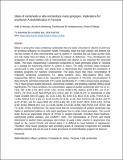| dc.description.abstract | Maize is among the crops containing carotenoids that are easily converted to vitamin A and have an enormous influence on consumers' health. Principally maize has high calories and proteins but has less number of other micronutrients such as vitamin A. Societies that use maize as their main and sole staple food are likely to be affected by vitamin A deficiency. Thus, development and production of maize varieties rich in micronutrients and vitamin A are important for improved health. This study characterized 5 carotenoid components in maize genotypes grown in Tanzania as a strategy for improving vitamin A content in maize. The study involved maize landraces, commercial or elite varieties, and inbred lines in determining their potential for provitamin A breeding programs for nutrition improvement. The study found that mean concentration of important carotenoid components, i.e., alpha carotene (AC), beta-carotene (BC), beta-cryptoxanthin (BCX), lutein (LU), zeaxanthin (ZX), provitamin A (ProVA), non-provitamin A (Non-ProVA), and total carotenoids (TC) varied significantly (P < 0.001) among maize genotypes. The 3 maize groups studied (landraces, commercial varieties, and breeding materials (BMs) varied significantly. For maize landraces, the concentration (µg/g) of studied carotenoids were AC (0.13–2.67), BC (0.60–3.72), BCX (0.36–1.01), ProVA (0.89–5.29), Retinol (0.25–0.87), LU (2.37–16.97). ZX (0.16–4.41), Non-ProVA (2.4–19.01), and TC (3.68–25.27); in commercial or elite maize varieties were (in µg/g): AC (0.31–3.84), BC (0.56–6.5), BCX (0.46–2.58), ProVA (0.92–11.80), Retinol (0.15–1.82), LU (3.28–22.39). ZX (0.05–11.31), Non-ProVA (2.56–28.81), and TC (4.23–37.84); and for maize BMs AC (0.53–6.64), BC (1.92–13.87), BCX (0.65–6.51), ProVA (2.69–18.62), Retinol (0.5–3.1), LU (4.86–34.99), ZX (0.06–18.58), Non-ProVA (4.8–53.57), and TC (9.86–76.94). Furthermore, the study found that the concentration of studied carotenoids was higher in pigmented (yellow or red) maize genotypes than in white maize genotypes. The current study found an appreciable amount of ProVA in studied materials, including maize landraces, commercial yellow varieties, and CIMMYT lines. The concentration of ProVA and retinol determined in studied maize genotypes were below 15 µg/g a daily vitamin A requirement, thus based on the current ProVA and retinol status it is difficult to meet Vitamin A requirement. Therefore, these maize genotypes with promising levels of carotenoid components are potential breeding materials that can be used in maize provitamin A biofortification program for improved food nutrition and livelihoods in Tanzania. | en_US |

